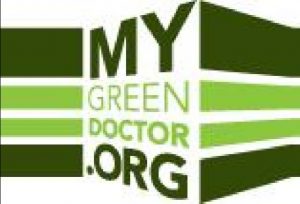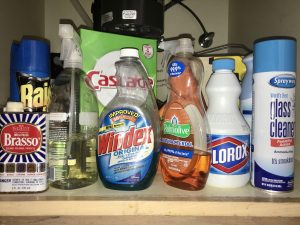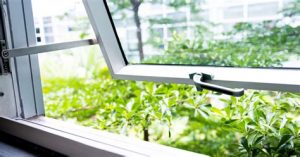 “Green Cleaning” means keeping toxic chemicals out of your office and home. Many societies have the dangerous attitude that proper cleaning means using lots of strong chemicals. This approach is not only wrong, it is also dangerous. My Green Doctor learned this at a recent lecture on Green Cleaning by Vickie Leonard, RN, PhD of the University of California School of Medicine at San Francisco (USA), at a meeting of the Mid-Atlantic Center for Children’s Health and the Environment.
“Green Cleaning” means keeping toxic chemicals out of your office and home. Many societies have the dangerous attitude that proper cleaning means using lots of strong chemicals. This approach is not only wrong, it is also dangerous. My Green Doctor learned this at a recent lecture on Green Cleaning by Vickie Leonard, RN, PhD of the University of California School of Medicine at San Francisco (USA), at a meeting of the Mid-Atlantic Center for Children’s Health and the Environment.
The first thing to know about cleaning is that “more” is usually not better. Our world and our bodies are covered with living bacteria, fungi and viruses. Most of these are not harmful and, in fact, many are beneficial and necessary for our health. Some diseases are being blamed in part on the Western World’s super-clean culture: resistant infections, childhood asthma, and autoimmune diseases such as rheumatoid arthritis and inflammatory bowel diseases Green Cleaning begins with not wasting your time by over-cleaning. Most pathogens—meaning 99% of bacteria, fungi, and viruses—will be eliminated with simple soap & water, with minimal scrubbing to remove films of bacteria and dirt that may be on a surface or fabric. Another My Green Doctor tip: hot water is not needed for this, so save the fossil fuels by using cold or warm water.
The second thing to know is when to use stronger approaches, and how. Stronger chemicals remove 99.9% of pathogens (this is called “sanitizing”) or even stronger chemicals remove 99.999% of pathogens (“disinfection”). Sanitizing and disinfecting are usually not wise. Exceptions might be the unusual major  contaminations with infectious body fluids: blood, urine, feces.
contaminations with infectious body fluids: blood, urine, feces.
Healthcare professionals need to disinfect surfaces in hospitals when working around pathogens such as COVID19 or HIV but this extreme cleaning is not needed and likely harmful in the home or usual work setting.
Here are two essential facts about sanitizing and disinfecting: 1) most products do not penetrate into dirty surfaces. Therefore, you must CLEAN FIRST with soap and water, and 2) these products must dwell on the surface for 10-15 minutes in order to eliminate that last 0.0001% of bugs. Most people do not clean first and think that a quick wipe-down with a potent disinfectant wipe will do the job, but this adds a toxic chemical into the room without solving the problem.
All sanitizers and disinfectant are hazardous, particularly to children. Asthma, thyroid disease, endocrine disruption, chronic lung disease and environmental damage have all been reported. These chemicals are now ubiquitous in our world, found in soil, rivers and the oceans. They are found in the blood of newborn babies even before their first bath! You should be particularly concerned about fragrances that are used to mask the chemical smell of cleaning products. Fragrances add no disinfectant benefit yet most are unregulated volatile organic compounds with health risks especially to people with asthma or to the developing lungs of young children. Dr Leonard tells her audiences that, “Clean is not a smell”, and that we need to be alarmed by the scents that give us a false sense of health. Also to be avoided: candles, with or without scent, air fresheners, and any other scented product. These are not smells of wellness!
You need to know about bleach. Bleach is a potent cause of asthma and lung disease in children and adults. In the United States, the top two occupations at risk for developing asthma are child care and nursing, likely due to the routine use of bleach. Bleach has actually been banned from cleaning products in Minnesota (USA) due to the dangers. You should not use bleach, or only in extreme contamination situations, and only after a thorough soap and water cleaning. Another bad chemical that should not be in your office or home is triclosan. Learn more about triclosan from My Green Doctor: https://mygreendoctor.org/safe-soap-cheaper-greener-by-avoiding-triclosan-2/ .
A great tool for routine cleaning is the “microcloth”. These are inexpensive, reusable cloths that are much more effective than sponges, cotton mops or paper towels. Microcloths remove 99% of pathogens without chemicals plus you can wash them up to 1000 times. Just remember not to wash them with cotton fabrics, bleach or fabric softeners as these ruin the bacteria-hugging ability of microcloths.
So what are the safest products? Always read carefully the label of any product you pick. Learn the  safest way to use it. You cannot rely on terms such as “natural”, “green” or “non-toxic” because these terms are unregulated. For the doctor office, speak with your supplier of cleaning products or with your custodial team. Look on labels for the logos of independent certifying organizations: Green Seal, EcoLogo, Design for the Environment, and the European Eco Label.
safest way to use it. You cannot rely on terms such as “natural”, “green” or “non-toxic” because these terms are unregulated. For the doctor office, speak with your supplier of cleaning products or with your custodial team. Look on labels for the logos of independent certifying organizations: Green Seal, EcoLogo, Design for the Environment, and the European Eco Label.
“Green Cleaning” means that most of the time we should simply “clean” with soap and water, without any sanitizing or disinfecting chemicals. It means using a microcloth rather than sponges and cotton mops. It means buying only cleaners with the logos on their labels indicating approval by an independent certifying organization. This is wise and will save you money.
 Author: Dr. Todd Sack is Editor of My Green Doctor, a free environmental sustainability program that is used by healthcare clinics, offices and outpatient centers in 60 countries and 43 US States. Your professional society can offer My Green Doctor as a free membership benefit. Send questions or suggestions to [email protected].
Author: Dr. Todd Sack is Editor of My Green Doctor, a free environmental sustainability program that is used by healthcare clinics, offices and outpatient centers in 60 countries and 43 US States. Your professional society can offer My Green Doctor as a free membership benefit. Send questions or suggestions to [email protected].

